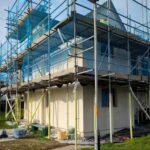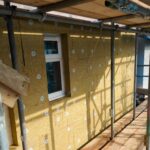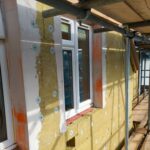In Retrofit by Robert Wheeler / 3 April 2024 / 0 comments

Building retrofitting is the process of upgrading and enhancing the performance of existing buildings to improve energy efficiency, sustainability & overall functionality. With the growing focus on sustainability and reducing environmental impact, retrofitting has become a crucial aspect of the construction industry.
This blog post explores the timeline and factors involved in retrofitting projects, providing an understanding of the time it takes to retrofit a building. By examining preparatory steps, project phases, potential challenges, and strategies for expediting the process, this blog post aims to shed light on the intricacies of building retrofitting and its impact on the construction industry.
Introduction to building retrofitting
Definition of building retrofitting
Building retrofitting refers to the process of making improvements or modifications to an existing building to enhance its energy efficiency, sustainability, functionality, and overall performance. It involves upgrading various systems and components within the building to meet current standards and address any deficiencies.
Importance of building retrofitting
Building retrofitting is becoming increasingly important in our efforts to combat climate change and reduce energy consumption. Many older buildings are not equipped with energy-efficient technologies, resulting in wasteful energy usage and high utility bills. Retrofitting allows us to optimize energy use, reduce greenhouse gas emissions, and create more comfortable and sustainable spaces. It also helps extend the lifespan of buildings, improve indoor air quality, and enhance the overall value and marketability of the property.
Factors influencing the duration of building retrofit projects
Size and complexity of the building
The size and complexity of a building greatly impact the duration of a retrofit project. Larger buildings typically require more time due to the increased number of systems and components that need to be modified or replaced. Complex structures with unique architectural features or intricate mechanical systems can also prolong the retrofitting process.
Scope of retrofitting work
The extent of the retrofitting work to be done plays a significant role in the project timeline. If only specific areas or systems within the building are being retrofitted, the duration may be shorter. However, comprehensive retrofits that encompass multiple aspects, such as insulation, HVAC systems, lighting, and water fixtures, will naturally take longer to complete.
Availability of resources
The availability of resources, including skilled labour, materials, and equipment, can impact the duration of a building retrofit project. If there is a shortage of qualified contractors or delays in procuring necessary materials, the timeline may be extended. Adequate planning and coordination are crucial to ensure that all required resources are available when needed.
Preparatory steps for a building retrofit
Initial assessment and analysis
Before embarking on a building retrofit project, an initial assessment and analysis of the existing structure are conducted. This involves identifying areas for improvement, evaluating the building’s energy performance, and determining the retrofitting goals. Proper assessment and analysis help establish a clear roadmap for the project and ensure that the retrofitting measures are tailored to the specific needs of the building.
Budgeting and financial planning
Budgeting and financial planning are essential steps in any retrofit project. Determining the available budget and securing financing if necessary play a crucial role in setting realistic expectations and avoiding delays. Adequate financial planning allows for proper allocation of funds to different retrofitting measures and helps ensure their successful implementation.
Obtaining necessary permits and approvals
To comply with local regulations and building codes, obtaining the necessary permits and approvals is an important preparatory step. This process may involve submitting retrofit plans, obtaining permits for construction activities, and coordinating with relevant authorities. Timely acquisition of permits helps prevent unnecessary delays during the retrofitting process.
Phases and timeline of a building retrofit project
Planning and design phase
The planning and design phase involves developing detailed retrofit plans, including architectural and engineering designs, technical specifications, and procurement strategies. This phase also includes evaluating different retrofit options and considering their potential impact on the project timeline. Adequate time should be allocated to ensure that the retrofit plans are comprehensive and align with the building’s objectives.
Procurement and contracting
The procurement and contracting phase involves sourcing materials, equipment, and services required for the retrofit project. This phase includes vendor selection, negotiating contracts, and ensuring timely delivery of materials. Careful management of procurement processes is crucial to avoid delays and ensure that all necessary resources are available when construction begins.
Construction and installation
The construction and installation phase is where the actual retrofit work takes place. This includes executing the planned modifications, replacing outdated systems, and installing new equipment. The duration of this phase is influenced by the scale of the retrofit, the complexity of the work, and the availability of skilled labour. Efficient project management and proper coordination among contractors are essential to keep the construction phase on schedule.
Testing and commissioning
After the construction work is completed, thorough testing and commissioning of the retrofitted systems and components are conducted. This ensures that everything functions as intended and meets the required standards. The duration of the testing and commissioning phase depends on the complexity of the retrofit and the number of systems involved. It is important to allow sufficient time for comprehensive testing to address any potential issues before finalizing the project.
Retrofitting a building is a complex and time-consuming process, but with proper planning, resource management, and efficient execution, the duration can be minimized. Each retrofit project is unique, and the timeline may vary depending on several factors. However, by understanding the key considerations and following a structured approach, building owners can successfully navigate the retrofitting journey and reap the long-term benefits of an upgraded and sustainable building.
Challenges and potential delays during retrofitting
Unforeseen structural issues
Retrofitting a building can be a bit like opening a can of worms. Once you start the process, you may uncover unexpected structural issues that need to be addressed. Whether it’s hidden deterioration, weak foundations, or outdated building systems, these surprises can cause delays and increase costs. It’s important to budget for these contingencies and work with experienced professionals who can assess the building’s condition accurately.
Coordination with tenants and occupants
When retrofitting a building, you’re not just dealing with bricks and mortar; you also have to consider the needs of the people who live or work in the building. Coordinating construction schedules, minimizing disruptions, and ensuring the safety of occupants are all vital considerations. It’s a delicate dance between progress and inconvenience, but open communication and proactive planning can help keep the process as smooth as possible.
Availability of skilled labour
Finding skilled labour can sometimes feel like searching for a unicorn in a haystack. Skilled workers, especially in specialized fields like retrofitting, can be in high demand. This scarcity can lead to delays in finding the right people for the job, potentially extending the retrofitting timeline. It’s important to connect with reputable contractors and build relationships with skilled professionals in advance to mitigate this challenge.
Strategies for expediting the retrofitting process
Prioritizing critical retrofit measures
Retrofitting a building is a complex process, and not all retrofit measures are created equal. By prioritizing critical retrofit measures that address immediate safety concerns or energy efficiency improvements, you can focus your efforts and resources where they are most needed. This approach allows for a more efficient retrofitting process, achieving significant benefits even if the entire project is not completed at once.
Streamlining project management and communication
Efficiency is the name of the game when it comes to retrofitting. Streamlining project management and communication between all stakeholders can help reduce delays and ensure smooth progress. Using digital tools for collaboration, setting clear project milestones, and establishing regular communication channels can make the retrofitting process more organized and less prone to hiccups.
Engaging experienced retrofitting contractors
When it comes to retrofitting, experience truly matters. Engaging contractors who specialize in retrofitting projects can make a world of difference. These experts understand the unique challenges involved and have the knowledge and skills to navigate them efficiently. While it may be tempting to go for the lowest bid, investing in experienced professionals will ultimately save you time, money, and headaches in the long run.
Case studies: Examples of successful building retrofit projects
Retrofitting a commercial office building
In this case study, a commercial office building successfully underwent a retrofitting project to improve energy efficiency. By prioritizing measures like insulation, upgraded HVAC systems, and efficient lighting, the building reduced its energy consumption by 30%. The retrofitting process took six months, including coordinating with tenants, and resulted in significant long-term savings on utility bills.
Retrofitting a residential apartment complex
This case study focuses on a residential apartment complex that required retrofitting for safety and accessibility. The project involved installing new fire alarm systems, upgrading elevators, and adding wheelchair ramps. The management team worked closely with residents to ensure minimal disruptions, and the retrofitting process was completed in nine months, resulting in increased safety and improved accessibility for all residents.
Retrofitting a historic landmark
Preserving history while retrofitting can be a delicate balancing act. In this case study, a historic landmark building underwent a retrofitting project to enhance energy efficiency without compromising its unique architectural features. The process involved carefully integrating modern insulation, upgrading windows, and implementing HVAC systems that blended seamlessly with the building’s aesthetics. The retrofitting project took a year to complete and successfully transformed the landmark into a sustainable and energy-efficient space.
Conclusion
In conclusion, retrofitting a building is a complex process that requires careful planning, coordination, and execution. The duration of a retrofit project depends on various factors such as the size and complexity of the building, the scope of work, and the availability of resources. While challenges and potential delays may arise during the retrofitting process, implementing strategies such as prioritizing critical measures and streamlining project management can help expedite the timeline. Successful case studies serve as inspiration and demonstrate the positive impact of retrofitting on energy efficiency and sustainability. By investing time and effort into building retrofitting, we can transform existing structures into more efficient, environmentally friendly, and functional spaces for the benefit of both occupants and the planet.
FAQs: How long does it take to retrofit a building?
The duration of a building retrofit project can vary significantly depending on factors such as the size and complexity of the building, the scope of work, and the availability of resources. Generally, retrofitting projects can take anywhere from several months to a year or more to complete.
There are several challenges that may arise during a building retrofit, leading to potential delays. Unforeseen structural issues, coordination difficulties with tenants and occupants, and a shortage of skilled labour are some common challenges that can impact the timeline of the project.
Yes, there are strategies that can help expedite the retrofitting process. Prioritizing critical retrofit measures, streamlining project management and communication, and engaging experienced retrofitting contractors are some effective strategies to accelerate the timeline and ensure a smoother execution of the project.
Absolutely! There are numerous examples of successful building retrofit projects. Some notable examples include retrofitting a commercial office building to achieve LEED certification, retrofitting a residential apartment complex to integrate renewable energy systems, and retrofitting a historic landmark to preserve its architectural integrity while enhancing energy efficiency.
Ready to discuss your regeneration project and how NXTGEN Futures Ltd can elevate it with expert retrofit? Contact us today!
Latest Retrofit Posts
- What a retrofit-first approach offers the UKRetrofitting is like giving your home a makeover to make it more energy-efficient, comfortable, and healthy. The retrofit-first approach prioritizes upgrading existing buildings over new construction to tackle climate change and improve living conditions. Definition of Retrofitting Retrofitting involves making… Read more: What a retrofit-first approach offers the UK
- What is internal wall insulation?Internal wall insulation is a crucial component of creating a comfortable and energy-efficient living space. By insulating the walls within a building, homeowners can experience benefits such as improved thermal performance, reduced energy bills, and enhanced acoustic comfort. Understanding the… Read more: What is internal wall insulation?
- What is a retrofit assessor?Retrofit assessors play a crucial role in the sustainability and energy efficiency of buildings by evaluating and identifying opportunities for improvement. This blog post aims to provide an in-depth understanding of the responsibilities, qualifications, and benefits associated with being a… Read more: What is a retrofit assessor?
- What is a retrofit assessment in the UK?Retrofit assessments play a crucial role in the sustainable development of buildings in the UK, helping to improve energy efficiency, reduce carbon emissions, and enhance overall building performance. By evaluating existing structures and identifying opportunities for upgrades and enhancements, retrofit… Read more: What is a retrofit assessment in the UK?
- Retrofit and Energy Efficiency in Historic BuildingsHistoric buildings are not only architectural treasures but also valuable cultural assets that contribute to our sense of history and identity. However, many of these buildings often suffer from poor energy efficiency, leading to excessive energy consumption and high operating… Read more: Retrofit and Energy Efficiency in Historic Buildings
- What is retrofitting in construction?Retrofitting in construction is a crucial process that involves upgrading existing buildings or structures to meet modern standards of safety, energy efficiency, and functionality. This blog post explores the concept of retrofitting, its importance, various techniques used in the industry,… Read more: What is retrofitting in construction?
- CASE STUDY: Curtis WayDelivering a Holistic Retrofit Solution with EWI & Solar Energy Project Overview NXTGEN Futures Ltd. successfully completed a large-scale retrofit project on Curtis Way, Berkhamsted, England, UK. This case study showcases our expertise in External Wall Insulation (EWI), retrofit coordination,… Read more: CASE STUDY: Curtis Way
- What happens to a building during retrofitting?Building retrofitting is a vital process that involves making significant modifications and improvements to existing structures to enhance their efficiency, functionality, and sustainability. In this blog post, we will delve into the intricate workings of building retrofitting, exploring the various… Read more: What happens to a building during retrofitting?
- UK Government Retrofit Scheme: Making Energy Efficiency Cool AgainIntroduction to the UK Government Retrofit Scheme Background of the Retrofit Scheme Picture this: you’re sitting at home, snuggled up in your favourite blanket, enjoying a cup of tea, when suddenly you feel a draft. Not cool, right? Well, that’s… Read more: UK Government Retrofit Scheme: Making Energy Efficiency Cool Again
- What are Retrofit Trickle Vents?Improving indoor air quality and enhancing energy efficiency are key priorities for many homeowners. In this article, we will explore the concept of retrofit trickle vents and their role in achieving these goals. Trickle vents are small, adjustable openings integrated… Read more: What are Retrofit Trickle Vents?
- Retrofit Underfloor HeatingRetrofit underfloor heating has gained significant popularity as a cost-effective and efficient solution for enhancing the comfort and energy efficiency of existing buildings. Unlike traditional radiator systems, underfloor heating distributes warmth evenly across the floor, providing a comfortable and cozy… Read more: Retrofit Underfloor Heating
- Retrofit LondonRetrofitting has emerged as a crucial solution in transforming the landscape of cities, and London is no exception. As a global hub of culture, commerce, and innovation, London faces the pressing challenge of reducing its carbon footprint while ensuring sustainable… Read more: Retrofit London












